Wednesday, July 24, 1929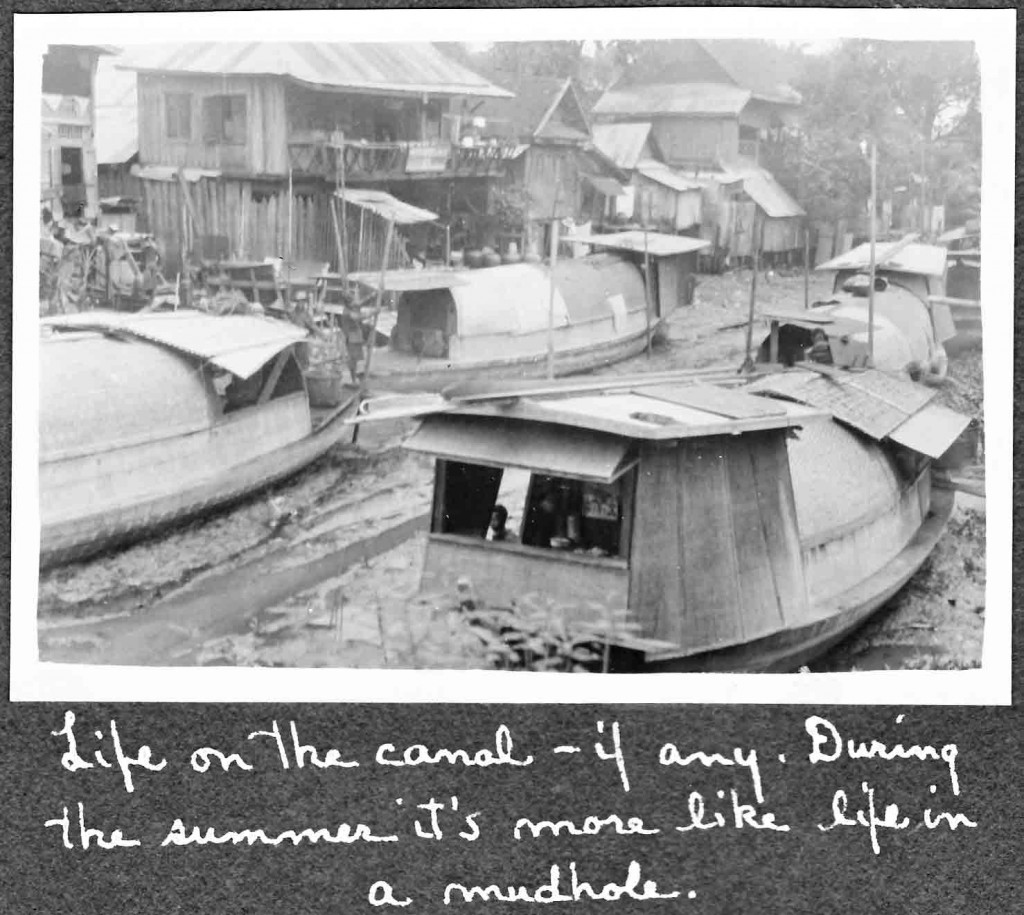
At last—shoes again—this is the sixth pair of soles on the trip. Went first to the station to get information about the trip to Saigon via Angkor and it was sad news. I figure about $25 (U.S.) for transportation alone, and with bungalows and hotels asking 13 piastres or $6.50 a day—and me with $40 for the trip and a week to spend at Angkor! There must be a cheaper way. Have inquired about biking it, but there is 100 miles of mud road liable to be (and probably) under water. The long way around is good but 500 or 600 kilometers. Would have to do 100 miles in one day over mud and flooded road or I would be caught in a mosquito-filled jungle with a few wild animals for companions.
 On the way from the station I passed a place where several hundreds of little ducks were just hatching from their shells—breaking them and trying to get out. Also saw the first beggar I have seen for a long time. The streets were busy scenes—of rikishas, peddlers carrying their wares in two large baskets, one at either end of a flexible, flat pole supported across the shoulder or the back of the neck—wooden slippers, meats, rice, all sorts of food, grains, vegetables, water, etc. Others squatted along the pavement selling betel nut, food, notions, etc. Those coming or going to market carried large baskets, often full of ducks. Shopkeepers stood before their open-faced shops jawing away to friends—money-lenders, jewelers, shoe shops, photo, dry goods, restaurants, tin shops, gun merchants, reed and wicker shops, etc. etc. Scores of half- or wholly naked youngsters played about the shops, sidewalks or gutters. Many of the men were tattooed with gods, necklaces, beautiful ladies who had lost their clothes, etc. Lots of the children had sores on their scalp—or
On the way from the station I passed a place where several hundreds of little ducks were just hatching from their shells—breaking them and trying to get out. Also saw the first beggar I have seen for a long time. The streets were busy scenes—of rikishas, peddlers carrying their wares in two large baskets, one at either end of a flexible, flat pole supported across the shoulder or the back of the neck—wooden slippers, meats, rice, all sorts of food, grains, vegetables, water, etc. Others squatted along the pavement selling betel nut, food, notions, etc. Those coming or going to market carried large baskets, often full of ducks. Shopkeepers stood before their open-faced shops jawing away to friends—money-lenders, jewelers, shoe shops, photo, dry goods, restaurants, tin shops, gun merchants, reed and wicker shops, etc. etc. Scores of half- or wholly naked youngsters played about the shops, sidewalks or gutters. Many of the men were tattooed with gods, necklaces, beautiful ladies who had lost their clothes, etc. Lots of the children had sores on their scalp—or their hair has all fallen out in spots. That seems quite prevalent in the peninsula and here among the babies and smaller children. You occasionally see an attractive girl or young lady. Fat men are nil here—unless it be a foreigner or a Europeanized Siamese or Chinaman who has fallen into the European and American popular bay window. Plenty are skinny though—often pitifully so. It must be the thing to do to smear white paint or grease on your face. It undoubtedly has something to do with religion—what, I don’t know.
their hair has all fallen out in spots. That seems quite prevalent in the peninsula and here among the babies and smaller children. You occasionally see an attractive girl or young lady. Fat men are nil here—unless it be a foreigner or a Europeanized Siamese or Chinaman who has fallen into the European and American popular bay window. Plenty are skinny though—often pitifully so. It must be the thing to do to smear white paint or grease on your face. It undoubtedly has something to do with religion—what, I don’t know.
 A typical street is always a novel sight. The architecture is not radical—nothing like the Wats. The buildings are for the most part very common-place, shabby looking most of them. But the Chinaman loves a loud display, and attains it by the lavish use of carving and gilt paint. Doorways, gables, signs—even the plain red and white signs that hang over the sidewalk produce a quaint effect as you glance down the street.
A typical street is always a novel sight. The architecture is not radical—nothing like the Wats. The buildings are for the most part very common-place, shabby looking most of them. But the Chinaman loves a loud display, and attains it by the lavish use of carving and gilt paint. Doorways, gables, signs—even the plain red and white signs that hang over the sidewalk produce a quaint effect as you glance down the street.
Bangkok is the possessor of a great many canals, none of them of large size. During the dry season these mostly dry up. As this is the first part of the S.W. monsoon, they are still pretty low, but a very few having enough water to even float a small boat. Thus dozens of boats of all descriptions are stuck in the mud till the water rises. A considerable number of people spend their lives on these canals. It must be an especially lovely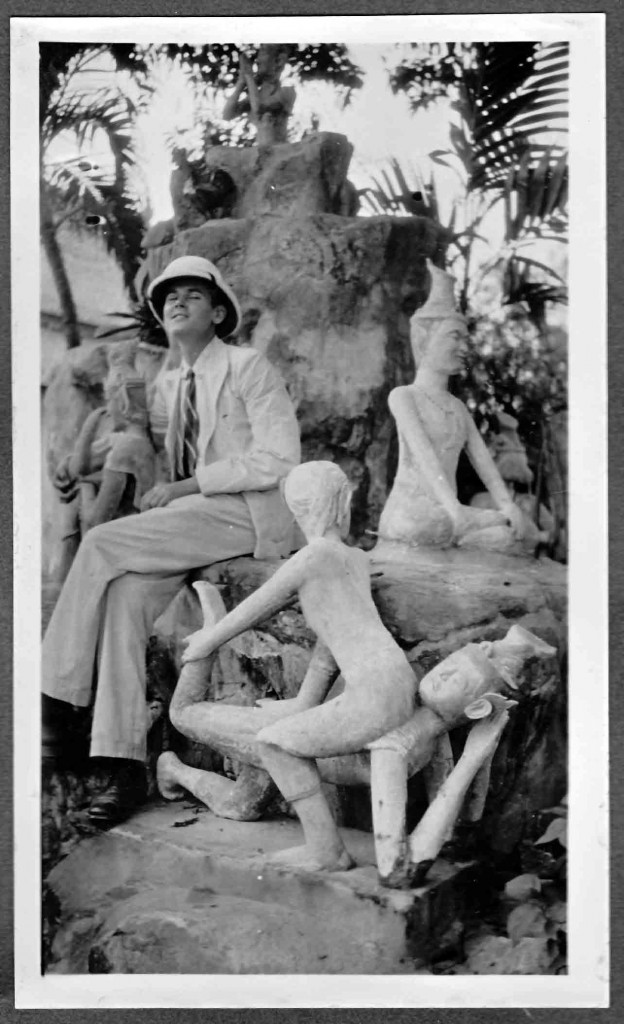 place to live about this time of year—a little shallow stream of semi-stagnant drainage, and on both sides a black, deep, slimy, foul-smelling much where hosts of mosquitoes breed. The city’s sewerage empties into these canals and there it stays till the rainy season. And into this mud men wade, scoop it up into baskets and carry it away for gardens. I prefer to be an Indian dung collector personally.
place to live about this time of year—a little shallow stream of semi-stagnant drainage, and on both sides a black, deep, slimy, foul-smelling much where hosts of mosquitoes breed. The city’s sewerage empties into these canals and there it stays till the rainy season. And into this mud men wade, scoop it up into baskets and carry it away for gardens. I prefer to be an Indian dung collector personally.
There are opium houses here but I shall save that for Saigon.
A long walk from the station brought me to the Pu Khao Tong or Golden Mount, one of the important landmarks of Bangkok.
King Phra Nang Klao or Rama III erected a huge phra chedi on this spot but had to give it up before completion because the weight of the structure was too heavy for the soil. However a later king took up the work and raised the present towering edifice over the crumbling structure of the other—a veritable brick mountain. The sides are adorned with small chedi and sala, caves, etc. and the growth of trees and vines on its slopes make it appear as a real hill. At its summit is a room enclosing another at a higher level in which is a sacred relic—and the place is only open in November during the Pu Khao Tong fair when thousands of faithful come to worship. The relic is a genuine bone of Buddha, discovered with other pieces in a huge earth-covered stupa at  Piprahwa near the Nepalese border in India. The Indian government divided the relics between the foremost Buddhist countries – viz. Ceylon, Burma, Siam, and Japan. Above the sacred relic rises a tall white phra chedi. The view is well worth the climb—palaces and Wats toward the river—main portion of the city and jungles to the south—Wats and jungles to the east, and the magnificent Throne Hall and Dusit Park to the north and Samsen, a northern suburb where many of the princes and nobles live. Much of the city is hidden beneath the dense foliage of its trees.
Piprahwa near the Nepalese border in India. The Indian government divided the relics between the foremost Buddhist countries – viz. Ceylon, Burma, Siam, and Japan. Above the sacred relic rises a tall white phra chedi. The view is well worth the climb—palaces and Wats toward the river—main portion of the city and jungles to the south—Wats and jungles to the east, and the magnificent Throne Hall and Dusit Park to the north and Samsen, a northern suburb where many of the princes and nobles live. Much of the city is hidden beneath the dense foliage of its trees.
Almost under the Golden Mount stands Wat Suket, a fair-sized place but much in need of repair. Its gallery I found closed and so could not see the Bôt which is of an ordinary Siamese temple style, having a three-storey roof supported by colonnades. Within is the usual sitting Buddha and some fresco work.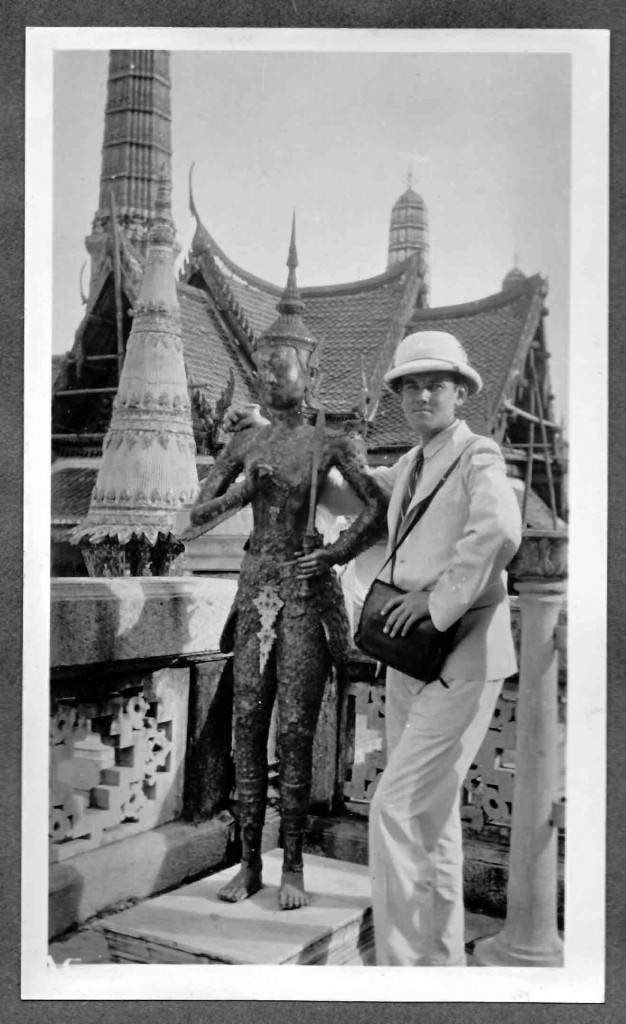
Inside the vihara is a gigantic standing gilt image of Buddha, 9 meters high, called Phra Buddha Attaroo. This bronze was brought down from the old capital of Pitsanuloke. The walls are frescoed and the teakwood doors are exquisitely carved and richly gilt. To the south lie the monks’ quarters. This Wat is an important one and is much used for cremations in the dry season.
Wat Sudat is from here a half-mile walk toward the river, and within the old city walls. In front is a large square in which stand two very tall posts with a crossbar at the top, the swing. Annually the Swinging Festival takes place in this square, Si Kak Sao China Cha.
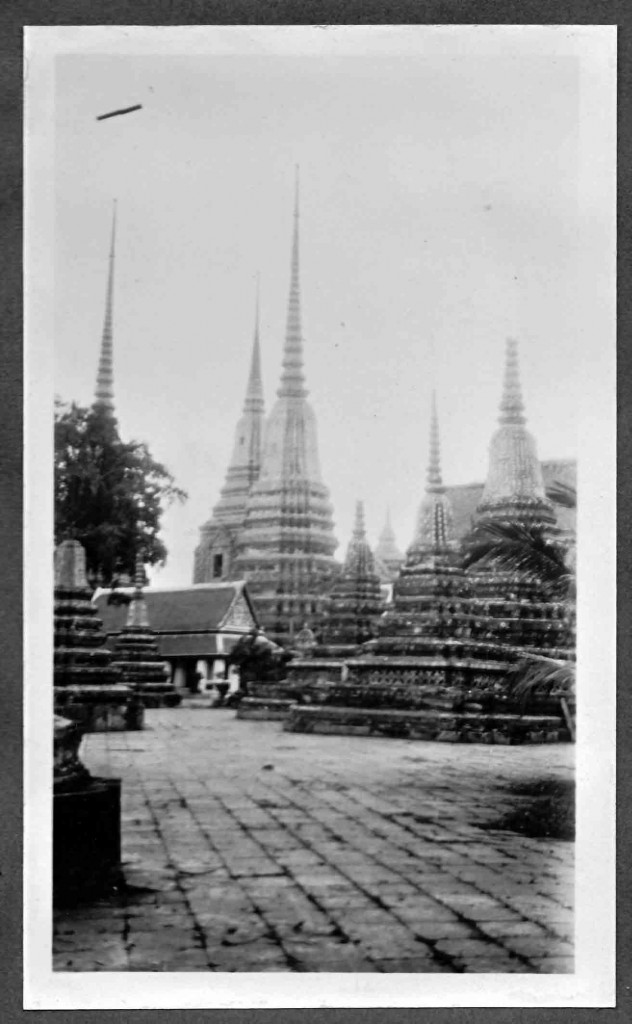 Wat Sudat—temple of the heaven of Indra, (Indra being the king of the gods), is one of the largest and finest in Bangkok. The large vihara stands in a closed court about which is a covered cloister or gallery where 160 gilt images of Buddha repose. The vihara stands on a double terrace and all about are curious stone figures of Chinese and Siamese design—warriors of China in ancient dresses, bronze horses, Chinese miniature pagodas, etc. The chô fa are richly encrusted with gilt glass that sparkles brilliantly in the sun. Tall lotus-capitalized pillars support a two-storey roof.
Wat Sudat—temple of the heaven of Indra, (Indra being the king of the gods), is one of the largest and finest in Bangkok. The large vihara stands in a closed court about which is a covered cloister or gallery where 160 gilt images of Buddha repose. The vihara stands on a double terrace and all about are curious stone figures of Chinese and Siamese design—warriors of China in ancient dresses, bronze horses, Chinese miniature pagodas, etc. The chô fa are richly encrusted with gilt glass that sparkles brilliantly in the sun. Tall lotus-capitalized pillars support a two-storey roof.
The three large doors in front are very interesting—of rich carving and heavily gilt, they represent the wonder forest of Hirnavan with its world of animals as described in the Ramayana. Inside, two rows of square, bepictured pillars form two naves. The brass Buddha stands on a richly ornate altar, dominating the room with his 9 meters of height. As usual, there are numerous other smaller images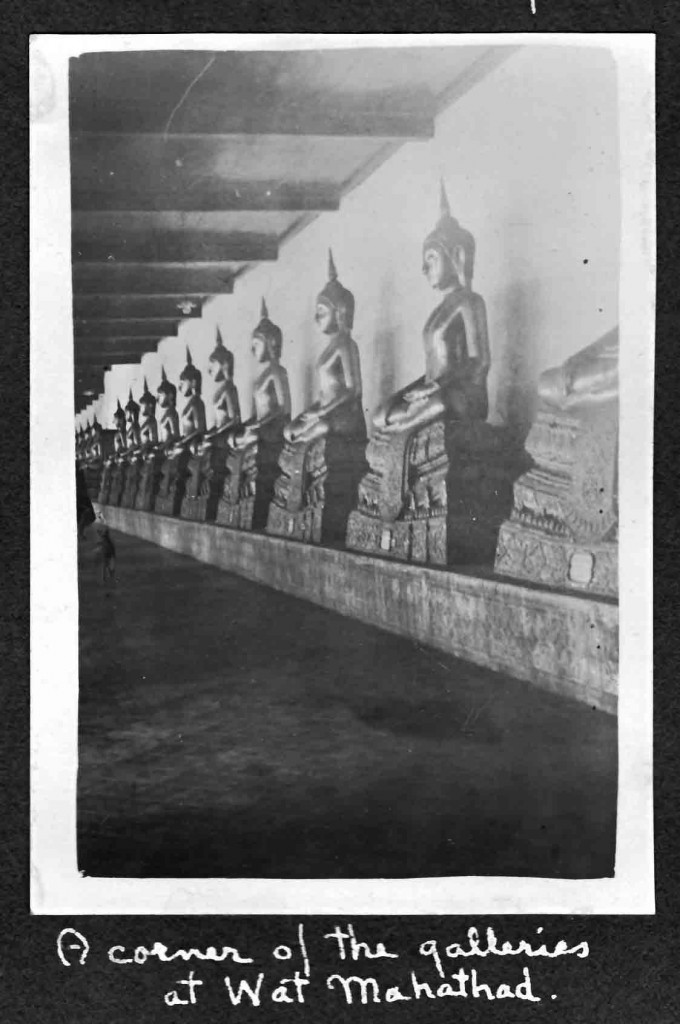 of Buddha about the room. The walls are decorated from top to bottom with scenes from the fatakas, i.e., the birth stories of the Buddha. This Buddha is a venerated one and barren mothers often come here to supplicate the Lord Buddha to give them a child. (This is a heretical belief as Buddha, being in Nirvana, can neither hear nor grant any prayers.)
of Buddha about the room. The walls are decorated from top to bottom with scenes from the fatakas, i.e., the birth stories of the Buddha. This Buddha is a venerated one and barren mothers often come here to supplicate the Lord Buddha to give them a child. (This is a heretical belief as Buddha, being in Nirvana, can neither hear nor grant any prayers.)
The Bôt is still more pretentious in the way of decorations than is the vihara. The exterior is surrounded with curious figures. Inside, a huge gilt Buddha greets you, sitting high upon his altar, and below a smaller Buddha surrounded by 80 still-smaller life-sized images of his disciples, all painted in natural color. It is an impressive scene. Walls are completely frescoed with scenes from the life of Buddha, and on the 52 window shutters a unique collection of gilt Hindu deities.
That was about enough for one morning. After lunch I hoofed it out to see the American Consul, a likeable chap newly here from Bombay. Supper over, Miss Rosenberg and I had an argument over willpower or determination over sea-sickness. Can’t agree though for she has fed the fishes too many times. Read a book till 2 AM.
